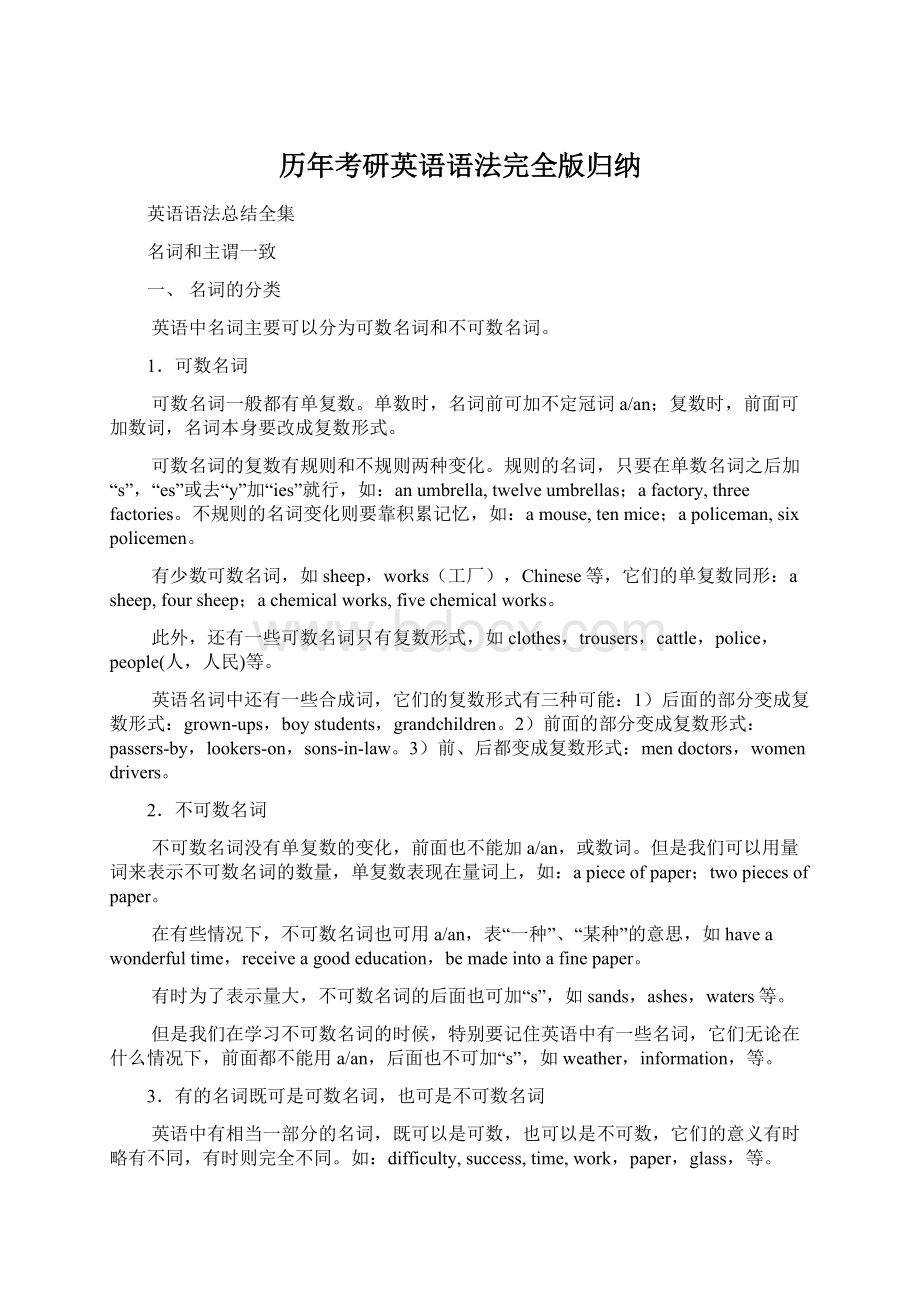历年考研英语语法完全版归纳.docx
《历年考研英语语法完全版归纳.docx》由会员分享,可在线阅读,更多相关《历年考研英语语法完全版归纳.docx(80页珍藏版)》请在冰豆网上搜索。

历年考研英语语法完全版归纳
英语语法总结全集
名词和主谓一致
一、名词的分类
英语中名词主要可以分为可数名词和不可数名词。
1.可数名词
可数名词一般都有单复数。
单数时,名词前可加不定冠词a/an;复数时,前面可加数词,名词本身要改成复数形式。
可数名词的复数有规则和不规则两种变化。
规则的名词,只要在单数名词之后加“s”,“es”或去“y”加“ies”就行,如:
anumbrella,twelveumbrellas;afactory,threefactories。
不规则的名词变化则要靠积累记忆,如:
amouse,tenmice;apoliceman,sixpolicemen。
有少数可数名词,如sheep,works(工厂),Chinese等,它们的单复数同形:
asheep,foursheep;achemicalworks,fivechemicalworks。
此外,还有一些可数名词只有复数形式,如clothes,trousers,cattle,police,people(人,人民)等。
英语名词中还有一些合成词,它们的复数形式有三种可能:
1)后面的部分变成复数形式:
grown-ups,boystudents,grandchildren。
2)前面的部分变成复数形式:
passers-by,lookers-on,sons-in-law。
3)前、后都变成复数形式:
mendoctors,womendrivers。
2.不可数名词
不可数名词没有单复数的变化,前面也不能加a/an,或数词。
但是我们可以用量词来表示不可数名词的数量,单复数表现在量词上,如:
apieceofpaper;twopiecesofpaper。
在有些情况下,不可数名词也可用a/an,表“一种”、“某种”的意思,如haveawonderfultime,receiveagoodeducation,bemadeintoafinepaper。
有时为了表示量大,不可数名词的后面也可加“s”,如sands,ashes,waters等。
但是我们在学习不可数名词的时候,特别要记住英语中有一些名词,它们无论在什么情况下,前面都不能用a/an,后面也不可加“s”,如weather,information,等。
3.有的名词既可是可数名词,也可是不可数名词
英语中有相当一部分的名词,既可以是可数,也可以是不可数,它们的意义有时略有不同,有时则完全不同。
如:
difficulty,success,time,work,paper,glass,等。
4.用于表示可数与不可数名词的数量“多”“少”的常用词和词组
跟可数名词连用的如:
few,afew,many。
跟不可数名词连用的如:
little,alittle,much。
可数与不可数都能用的是:
alotof,plentyof。
二、主谓一致
1.通常被看作单数的主语部分
1)不定式、动名词和主语从句。
eg..Toseeistobelieve.
Seeingisbelieving.
Whathesaidwasdifferentfromwhathedid.
2)表示“时间”“距离”“金钱数量”的名词。
eg.Twentyyearsisquitealongtime.
10kilometersdoesn’tseemtobealongdistancetoMira.
300dollarsistoomuchforthisoldcoin.
3)数学式子。
eg.Twoplusfiveisseven.
4)书报杂志、、单位的名字。
eg.TheTimesispublisheddaily.
TheUnitedStatesisabigcountry.
5)前面用akindof,asortof或thiskindof,thissortof等词组的名词。
eg.Thiskindoftree(s)oftengrowswellinwarmweather.
6)代词either,neither作主语。
eg.Eitheroftheplansisgood.
Neitherofthemwascarryingaweapon.
7)manya/morethanone加单数名词,或oneoutof加复数名词作主语。
eg.Manyayoungmanhastriedandfailed.
Morethanoneemployeehasbeendismissed.
Oneoutoftenthousandcomputerswasinfectedwiththevirus.
2.通常被看作复数的主语部分
1)一些只有复数的名词如clothes,trousers,police等。
eg.Thesetrousersaredirty.
但要注意比较:
Anewpairoftrousersiswhatyouneed。
2)代词both作主语。
eg.Bothofthemhavereceivedhigheducation.
3.需要进行分析才能确定的主语部分
1)代词all,some,作主语。
所代的名词是可数名词,就看作复数;是不可数名词,就看作单数。
eg.Allisready.(=Everythingisready.)
Allarepresent.(=Allthepeople/students...arepresent.)
2)alotof,lotsof,plentyof,some,any,20%of,halfof...等词组作主语。
所修饰的名词是可数名词,就看作复数;是不可数名词,就看作单数。
eg.70%ofthesurfaceoftheearthiscoveredwithwater.
90%ofthegraduatesfromthehighschoolgotouniversity.
3)关系代词who,which,that作主语。
由先行词决定单、复数。
eg.ThestudentwhoistalkingwiththeprincipalisTom.
Thestudentswhohavechosenphysicswillhaveatesttomorrow.
但要注意oneof...与onlyoneof...所修饰的先行词。
eg.HeisoneofthestudentsinourclasswhohavebeentoBeijing.
HeistheonlyoneofthestudentswhohasbeentoLondon.
4)一些表示集体意义的名词如family,team,class等。
当这些名词强调的是一个整体时,看作单数;当它们强调的是这个集体中的成员时,看作复数。
eg.Happyfamiliesareallalike;everyunhappyfamilyisunhappyinitsownway.
Myfamilyareallearlyrisers.
4.出现在句首,用连词或介词连接的两个名词或词组
1)用both...and...连接的两个名词看作复数。
BothKateandJeanarefootballplayers.
2)用or,either...or...,neither...nor...,notonly...butalso...连接的两个名词,由靠近动词的名词决定单复数。
EitheryouorIamtogo.
Notonlythestudentsbutalsotheteacherhastoobservetherules.
3)用aswellas,(together)with,like,besides,but,except等连接的两个名词,由第一个名词决定单复数。
eg.Hiseyebrowsaswellashishairarenowwhite.
Noonebutthesetwopeasantshasbeenthere.
实际上这些都是介词短语提前,不是并列的主语。
4)用and连接的两个名词有几种情况:
a)看作复数。
eg.TomandMaryareprimarypupils.
b)在有every...andevery...,each...andeach...的时候;或用and连接的两个名词表示的是一件东西或一个人时,看作单数。
eg.Everyboyandeverygirlinourcountryhastherighttogotoschool.
Breadandbutteriswhatheeatsforbreakfasteveryday.
考研真题试析:
Asaresultofdestroyingtheforests,alarge____ofdesert____coveredtheland.
A.number;hasB.quantity;hasC.number;haveD.quantity;have
选B。
因为第一格后的名词desert是不可数名词,所以A、C两项排除;又desert做主语,谓语要用单数形式。
Heistheonlyoneofthestudentswho____awinnerofscholarshipforthreeyears.
A.isB.areC.havebeenD.hasbeen
选D。
因为定语从句的先行词是由onlyoneof修饰,所以应看成单数;另外后面有时间状语forthreeyears,所以用现在完成时态。
Theyoungdancerslookedsocharmingintheirbeautifulclothesthatwetook____picturesofthem.
A.manyofB.massesofC.thenumberofD.alargeamountof
选B。
空格后面的名词是复数,所以不可以选D,而many后不跟of用,所以A项排除;thenumberof的确是放在可数名词复数的前面,但意思是“......的数量”,不符合题意。
Whereandwhentogofortheon-salaryholiday____yet.
A.arenotdecidedB.havenotbeendecided
C.isnotbeingdecidedD.hasnotbeendecided
选D。
此句是不定式做主语,看成单数。
而C项的时态不对,所以只有D。
NooneinthedepartmentbutTomandI____thatthedirectorisgoingtoresign.
A.knowsB.knowC.haveknownD.amtoknow
选A。
谓语动词应该跟noone一致,所以选A。
Wehaveonlyasofa,atableandabedinournewapartment.Weneedtobuy____morefurniture.
A.anyB.manyC.littleD.some
选D。
后面的名词是furniture,不可数。
而且整句的意思是“要买些家具”,是肯定意义,所以选D。
Telephonemessagesforthemanager____onherdeskbutshedidn’tnoticethem.
A.wereleftB.wasleftC.wasleavingD.wereleaving
选A。
句子的主语是messages,是复数,另外它与动词“留(在桌上)”的关系是被动。
ProfessorSmith,alongwithhisassistants,____ontheprojectdayandnighttomeetthedeadline.
A.workB.workingC.isworkingD.areworking
选C。
谓语的单复数跟ProfessorSmith一致,应该是单数。
动词的时态与语态
一、动词的时态
英语的动词可以有十六种变化,但现在常用的是十二种,其中有九种是高中学生必须掌握的,还有三种只要理解。
现以动词do为例,十二种时态的形式列表如下:
一般
进行
完成
完成进行
现在
do/does
is/am/aredoing
have/hasdone
have/hasbeendoing
过去
did
was/weredoing
haddone
*hadbeendoing
将来
shall/willdo
*shall/willbedoing
*shall/willhavedone
过去将来
woulddo
(打星号的为理解项目)
1.一般现在时态
A)意义:
现阶段经常反复发生的动作或现在的状态。
eg.Hegetsupatsixeverymorning.
Thereisabigtreeinthebackyard.
B)常用的时间状语:
always,often,usually,sometimes,seldom,never,everyday,onceaweek,等。
C)表示一种真理、自然规律等,在间接引语中也仍然用一般现在时态。
eg.Thescientistexplainedthattheearthgoesroundthesun,butnoonebelievedhimthen.
D)在时间、条件等状语从句中,代替将来时。
eg.Ifheisnotbusy,hewillcometothepartytomorrow.
E)注意第三人称单数时,动词后面要加“s”。
2.一般过去时态
A)意义:
过去的动作或状态。
注意,即使是刚刚发生的事情,时间非常短,也要用过去时态。
如:
Why!
It’syou—Mary!
Ididn’tknowyouwerehere!
B)常用的时间状语:
yesterday,lastweek,3yearsago,justnow,等。
C)动词过去式的规则变化(加ed)和不规则变化。
3.一般将来时态
A)意义:
将来要发生的动作或状态。
B)常用的时间状语:
tomorrow,nextmoth,intwoweeks,等。
C)除了用shall/will之外的将来表达法:
a)is/am/aregoingtodo,意为“打算、准备、马上就要”。
eg.It’sgoingtorain.
b)is/am/aretodo,意为“(计划好/安排好)要......”
eg.Thenewundergroundrailwayistobeopenedtotrafficnextyear.
c)is/am/areabouttodo,意为“马上就要”。
eg.Hurryup!
Theplaneisabouttotakeoff.
d)某些动词(主要是一些表示位置移动的动词)可用一般现在时态或现在进行时态表示将来的动作。
eg.ThetrainleavesforBeijingat8:
30thisevening.
HeisgoingtoLondonnextweek.
4.现在进行时态
A)意义:
表示在说话的同时或最近一个阶段正在发生的动作。
B)常用的时间状语:
now,thesedays,atpresent,atthemoment,等。
C)有时可以和always,constantly,forever等时间状语连用,表示说话人的某中特殊的感情。
eg.Heisalwaysthinkingofothers.
MrsSmithisconstantlyquarrellingwithherneighbours.
D)有些瞬间动词可以用进行时态表示“马上就要......”
eg.Theoldmanisdying.
E)英语中有些表示状态、感觉、心理活动的动词没有进行时态,如know,understand,believe,like,love,see,hear,seem,等等。
5.过去进行时态
A)意义:
表示过去某个时刻正在做的动作。
B)常用的时间状语:
thistimeyesterday,at9:
00lastnight,等。
C)有些动词(主要是一些表示位置移动等的动词和瞬间动词)的过去进行时态可以表示过去将来的意义。
eg.IwastoldthatshewasleavingforAustraliathenextmorning.
*6.将来进行时态
A)意义:
表示将来某个时刻正在发生的动作。
B)常用的时间状语:
thistimetomorrow,at9:
00nextSundaymorning,等。
eg.Whatwillyoubedoingat9:
00onJune7nextyear?
7.现在完成时态
A)意义:
a.表示过去某个时刻开始,一直持续到现在的动作或状态。
(只有部分延续性动词,如live,work,study,等可以表示这一意义)
eg.IhavelivedinShanghaisinceIwasborn.
Hehasbeenmarriedforhalfayear.
b.表示过去做过的某一个动作对现在的影响。
eg.Ihaveseenthisfilm.It’sfantastic!
Jackisplayingvideogames,becausehehasdonehishomework.
B)常用的时间状语:
a.since1990,for9years,等。
b.already,yet,just,now,thisweek,never,ever,sofar,uptillnow,lately,inthepast/lastfewyears,等。
C)b组所表示的现在完成时态与过去时态的区别:
虽然现在完成时态b组表示的动作也是发生在过去,但它强调的是与现在的关系,而过去时态只表示过去发生的动作,叙述一个事实。
试比较:
eg.1)HewenttoBeijingtwodaysago.
HehasgonetoBeijing.
2)Henrylosthismobilephoneyesterday,butfounditlater.
Henryhaslosthismobilephoneagain.
D)瞬间动词要表示“一直到现在”,不能直接用“完成时态加for”的方式,必须用其他句型。
eg.他离开上海已经三天了。
HehasleftShanghai.Heleftthreedaysago.
HehasbeenawayfromShanghaiforthreedays.
ItisthreedayssinceheleftShanghai.
8.过去完成时态
A)意义:
表示过去某个时刻之前所做的动作,即“过去的过去”。
所以一般要用过去完成时态的话,句子中或上下文一定有一个过去时态的动作或时间状语做比较,才能用。
eg.HehadlearnedEnglishbeforehewenttoCanada.
B)常用的时间状语:
bytheendoflastyear等。
C)在用间接引语时,主句的动词是过去时态,用来替换直接引语中的过去时态或现在完成时态。
eg.Heaskedthegirl,“Wherehaveyoubeen?
”
→Heaskedthegirlwhereshehadbeen.
Hesaid,“Icleanedtheclassroomyesterday.”
→Hesaidthathehadcleanedtheroomthedaybefore.
D)有些动词(如hope,wish,expect,think,intend,mean,suppose等)的过去完成时态可表示过去事实上没有实现的希望、计划等。
eg.Ihadhopedtoattendtheparty,butIwastoobusy.
*9.将来完成时态
A)意义:
表示在将来某个时刻之前将会完成的动作。
B)常用的时间状语:
bytheendofnextyear等。
eg.YouwillhavestudiedEnglishfor10yearsbythetimeyoufinishhighschool.
10.现在完成进行时态
A)意义:
表示一个动作从过去开始,一直持续到现在。
(同现在完成时态的第一种意义)
B)常用时间状语:
since...,for...,sofar,uptillnow等。
C)现在完成进行时态与现在完成时态的比较:
只有现在完成时态的第一种意义的那些动词,它们的现在完成与现在完成进行两种时态表示的意义相同,可以互换使用。
eg.Ihavestudiedherefor3years.=Ihavebeenstudyingherefor3years.
而其他的一些动词,使用两种时态,意义就各不相同了。
试比较:
Thelittleboyhasreadthetext.(小男孩已经读过课文了。
)
Thelittleboyhasbeenreadingthetext.(小男孩一直在读课文。
)
试翻译:
1